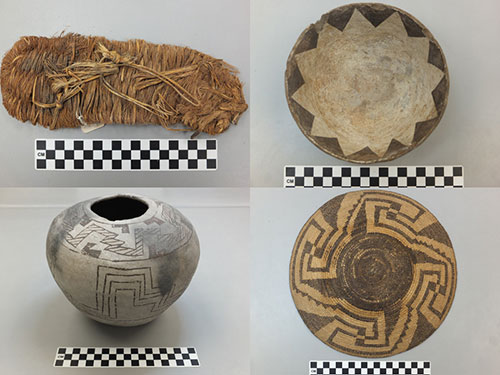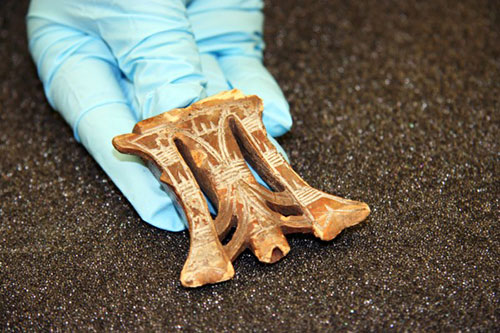
Museums bring objects closer to homeBy THERESA BAKKER
December 04, 2014
The shipment signified the reversal of a trend in the mid-20th Century to move cultural artifacts around the country among museums in an effort to tell the story of the first peoples. Now archaeologists recognize the value of keeping these collections closer to their communities of origin.
These artifacts were returned recently to Arizona State Museum from the UA Museum of the North. Clockwise from upper left: Sandal made of yucca leaves from the Pueblo III period (AD 1150-1350). Black-on-white bowl from a Pueblo II period (AD 900-1100) site near Flagstaff, Arizona. A historic Pima coiled basket from Phoenix, Arizona. Black-on-white jar from a Pueblo IV period (AD 1300-1450) site near Holbrook, Arizona.
The box contained a wide variety of items, from harpoon heads and arrowheads to knife handles and a needle case. The box also contained human figurines and images, carved bears, winged objects and combs. Josh Reuther is the UAMN curator of archaeology. His focus is on geoarchaeology — understanding the changes in human technological and subsistence systems. But he has another responsibility. To ensure that the people who live in both urban and rural communities of Alaska and the museum have a role in understanding the history and prehistory of the development of those landscapes. “We wanted to bring the collections back to the regions where they were collected,” he said. “So that they will be available to both community members and researchers.” Reuther also has a connection to Arizona. It’s where he got his Ph.D. During a visit to the Arizona State Museum in Tucson last year, he discussed the possibility of returning the objects exchanged by the two museums. “All were in favor of the concept,” Reuther said. “We agreed it was the right thing to do. Neither collections were being fully utilized as far as research, teaching and public visitation because they were far away from the regional areas where they were collected.” John McClelland is the Native American Graves Protection and Repatriation Act coordinator at ASM. He said the original exchanges occurred during a period when most large museums sought to assemble collections for exhibits that represented cultures throughout the United States and the world. “Since then, collections policies have changed considerably, partly because of ongoing consultation and collaboration with Native American tribes and Native Alaskan villages,” he said. “Many tribal representatives now prefer that the objects made by their ancestors remain in the region where they originated.”
An ivory harpoon counterweight, this artifact was collected on St. Lawrence Island, Alaska, in 1927. It was recently returned from the Arizona State Museum, where it had been on loan since 1955.
“Researchers and community members in Arizona will be excited to have these collections back,” he said. “Especially the complete pots and sandal fragments, which aren’t always well-preserved in the archaeological record and therefore pretty rare.” Curators at ASM have begun reintegrating the returned items with existing collections. McClelland said information about the returned items will also be shared with tribal representatives. UAMN will continue to seek the return of Alaska items by reaching out to more museums in the Lower 48 and coordinating exchanges like this one. “We are hoping to reunite objects from several collections that were broken up, piecemeal, with the communities where they were collected,” Reuther said. “Reuniting all of the parts and pieces of these collections will also help researchers who will be able to come to one place to view and analyze artifacts. Hopefully this will encourage development of more research in the collections.”
THERESA BAKKER is a UA Museum Admin. Communications Manager
Source of News:
|
||

